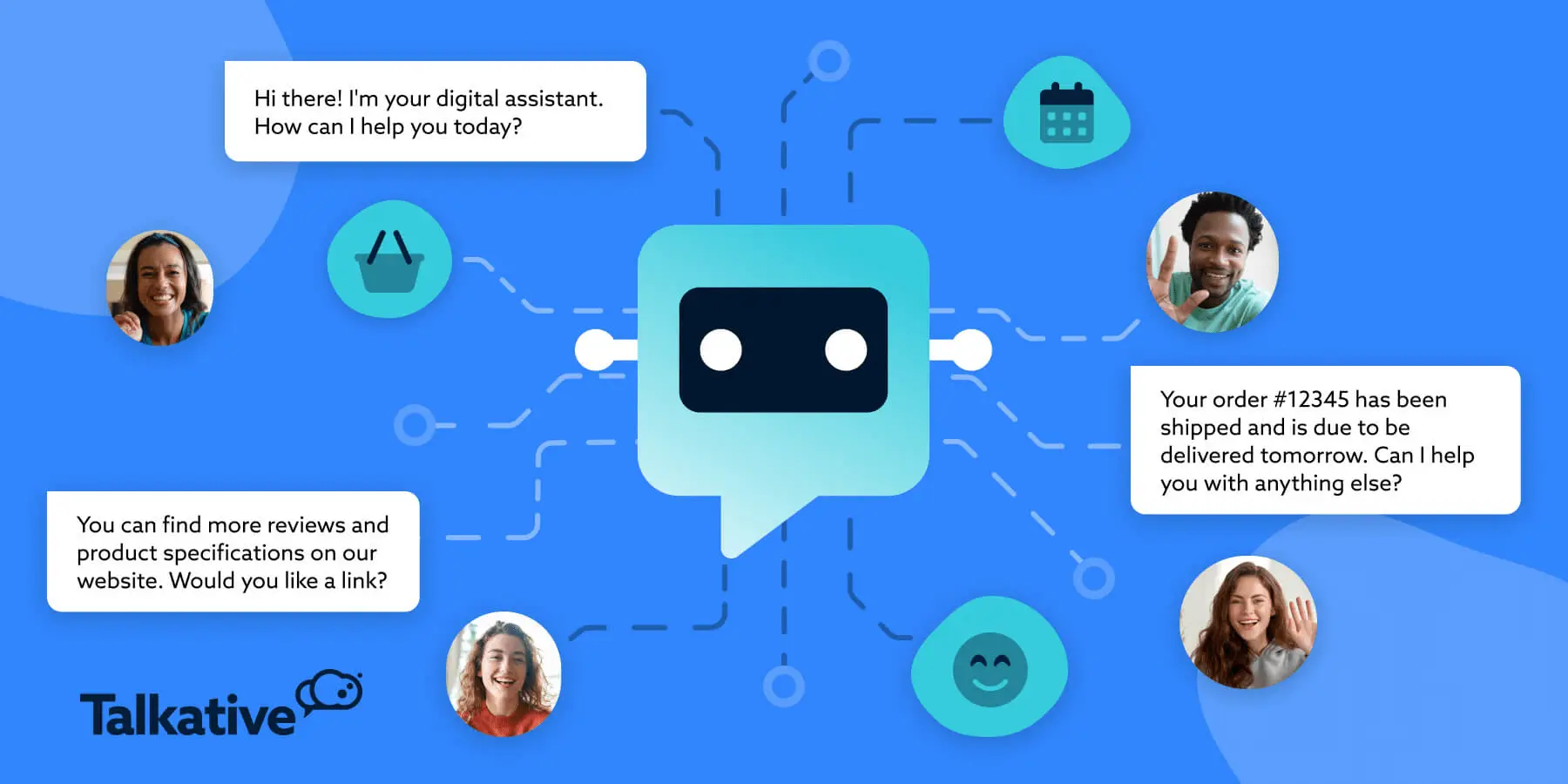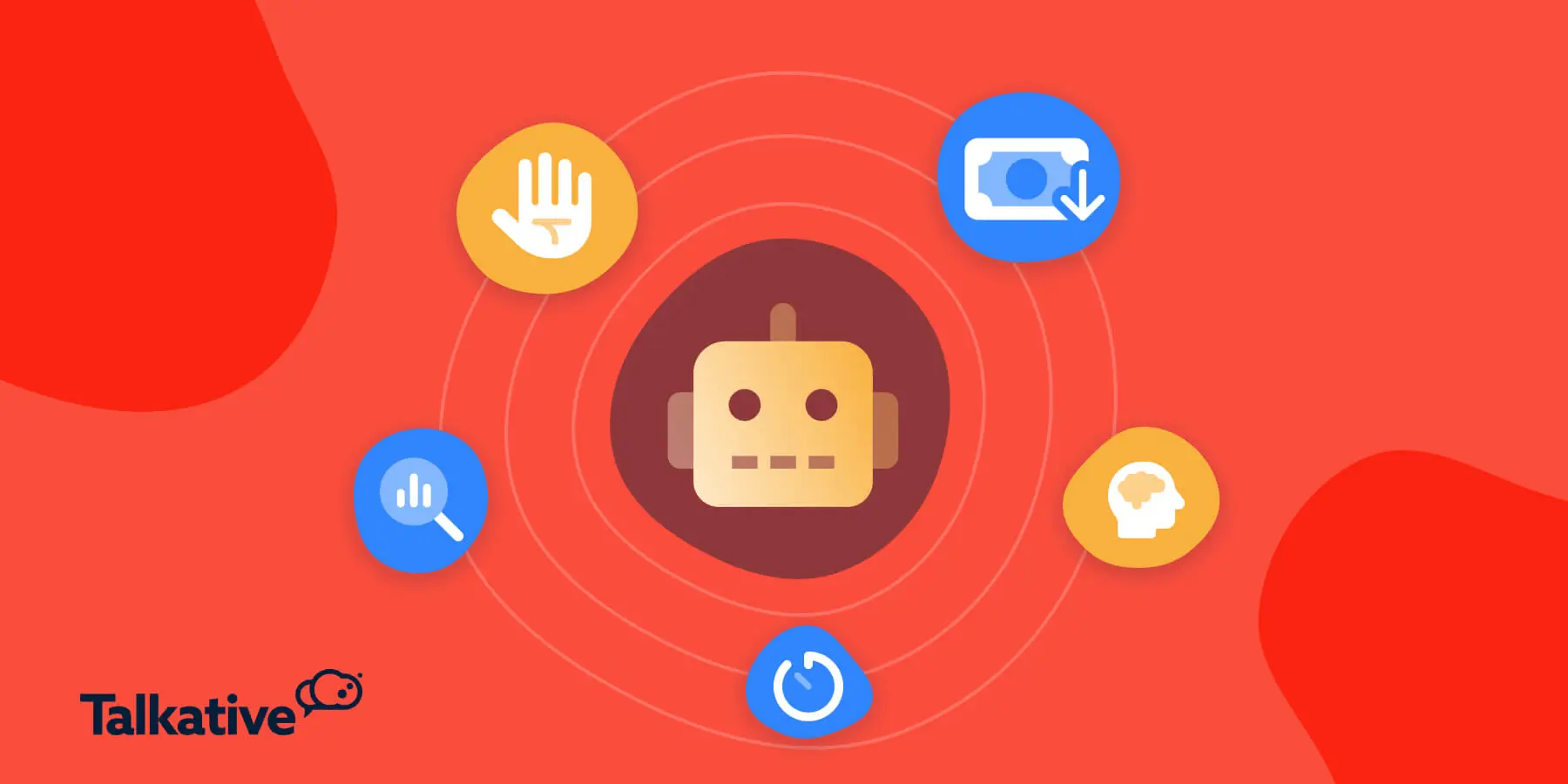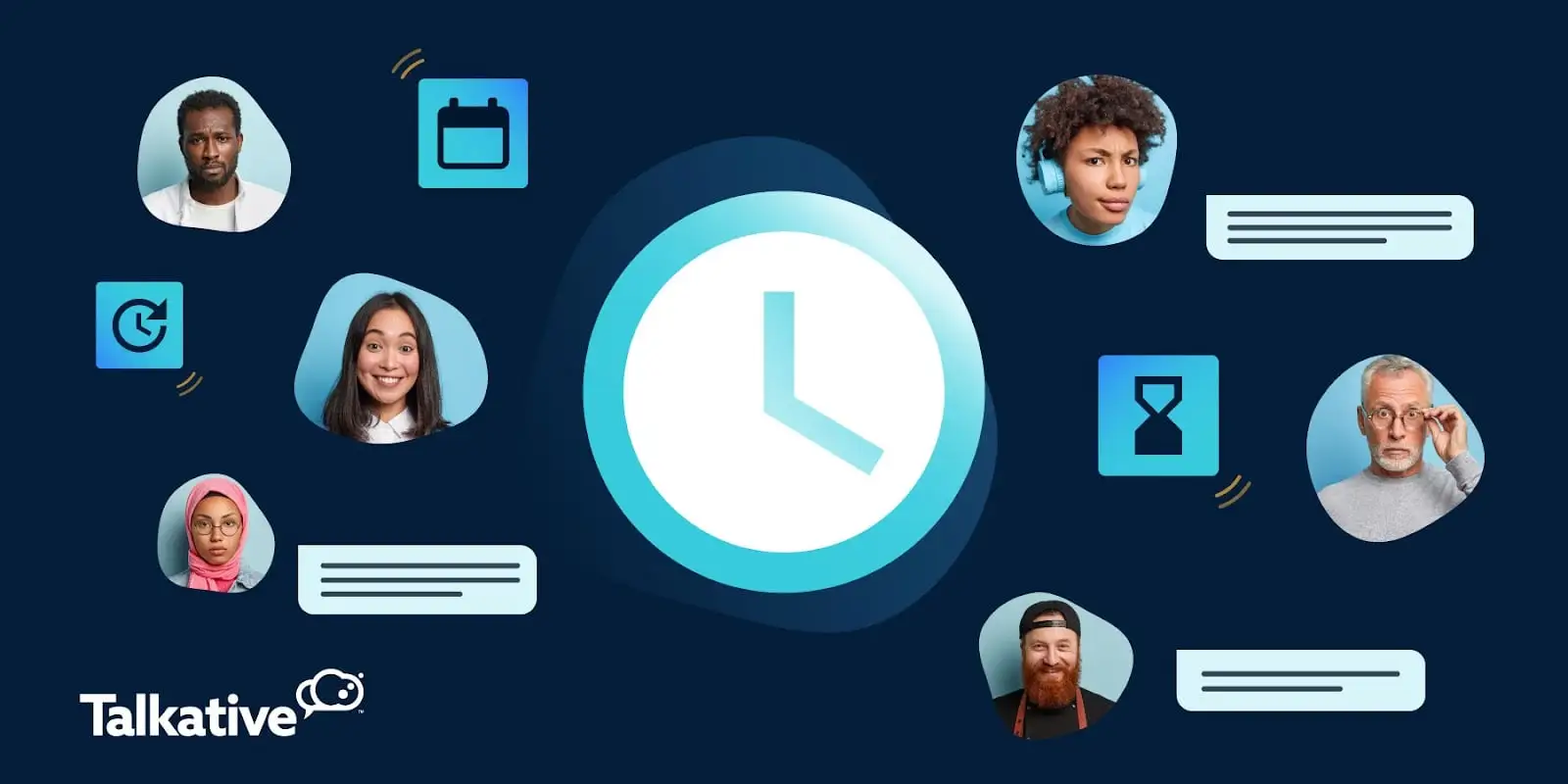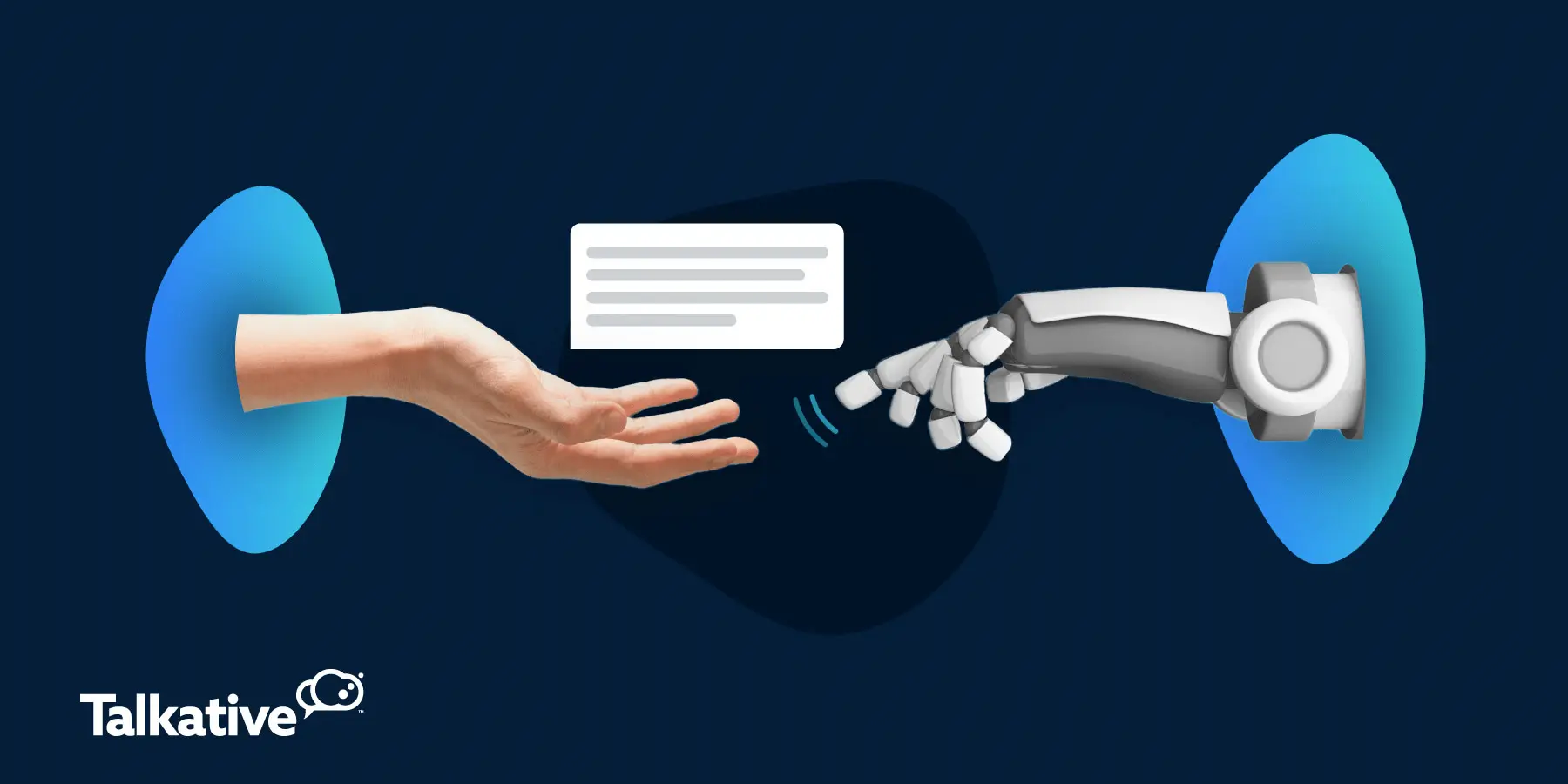Virtual agents are powerful customer service chatbots that can reduce operational costs and improve efficiency.
That's why they're becoming an increasingly popular tool in contact centres.
In fact, 80% of businesses are expected to be using some form of AI virtual assistant or chatbot by the end of 2022.
If you're considering utilizing this technology for your own business, then you've come to the right place.
In this article, we'll provide everything you need to know about virtual agents before you deploy one of your own. We'll cover:
- What are virtual agents?
- How virtual agent chatbots work
- The benefits of intelligent virtual agents
- Best practices to get the most out of a virtual agent solution

What is a virtual agent?
Virtual agents are advanced, AI-powered chatbot solutions typically used for digital customer support.
They're often implemented to provide immediate responses to customer questions and/or to field initial queries before routing the customer to a human agent.
There a number of use cases for virtual agents, including:
- Automated customer service
- Marketing
- Lead generation
- Retail & ecommerce
- Travel & hospitality
- Finance & insurance

Virtual agents vs. chatbots
The difference between virtual agents and chatbots is not always clear, and the terms are often used interchangeably.
The easiest way to differentiate between the two is to look at their capabilities - virtual agents are typically more advanced than chatbots.
- Chatbot: A chatbot is typically designed to handle basic communication tasks. Traditional chatbots are programmed to respond to questions with pre-approved answers using scripted decision trees. When a customer enters a query, the chatbot picks up keywords and responds with the most suitable scripted response. In a lot of cases, chatbots require customers to choose responses from set phrases (e.g. to start the conversation the customer chooses between ‘account’, ‘order’ or ‘billing’), which limits the scope of user input and therefore the questions the chatbot can be asked.
- Virtual agent: Virtual agents are designed to interact with a customer in a conversational manner. Rather than relying purely on scripted answers, a virtual agent uses artificial intelligence (e.g. natural language processing, conversational AI) to understand a customer’s intent and respond in a more personalized, ‘human-like’ way. An advanced virtual agent can also ‘remember’ previous interactions, which means it can learn to handle more and more customer queries.

How do virtual agents work?
A virtual agent leverages artificial intelligence and its knowledge base to answer customer queries in a conversational way.
When a customer sends a message, the virtual agent will analyse the words to determine sentiment and intent.
Based on this, it will use the information in its knowledge base, AI, and experience from past interactions to respond.
Instead of solely relying on scripted responses like traditional, rule-based chatbots, AI virtual agents leverage technologies like:
- Conversational AI
- Natural Language Processing (NLP) & Natural Language Understanding (NLU)
- Generative AI
- Machine Learning
- Large Language Models (LLMs)
These technologies make virtual assistant chatbots capable of handling a wide range of customer queries in a human-like way.

Key benefits of virtual agents for businesses & customers
Virtual agent technology has many use cases and can bring plenty of benefits to a business.
To help you determine whether your contact centre needs to invest in a virtual agent platform, let’s take a look at the benefits in more detail.
Improved customer experience
An intelligent virtual agent can help improve the customer experience in a number of ways:
- Fast responses: One of the most important factors in determining a good customer experience is a fast response to queries. Virtual agents can answer customers instantly, making them a reliable way to boost customer satisfaction through fast and efficient support.
- Reduce contact centre queues: Both phone and live chat queues are a big turn off for customers. In fact, 60% of customers aren’t even willing to wait on hold for just one minute. One of the best ways to reduce contact centre queues is to provide a virtual agent. As the virtual agent deflects customer interactions via automation, it reduces the demand on other channels and decreases agent workloads.
- Gather customer insights: Virtual agents are a great way to gather information and data on customer behaviour and journeys. What are the most frequent questions it answers? What webpages trigger the greatest number of interactions? Insights such as this can show you where in the digital customer journey your customers encounter problems. You can then work to improve these areas and offer proactive customer support.

Reduce demand on agents
As a virtual agent can handle many customer requests, it is a great tool for reducing the demand on human agents in a busy contact centre.
This will give agents more time to deal with complex customer problems and improve employee morale.
Of course, an AI virtual assistant can never completely replace agents - but it can be a useful complement to human-powered customer support.

Round the clock support
Being able to offer 24/7 customer support with a virtual agent is a clear benefit for your contact centre.
An automated virtual agent can operate without human input, which means it can manage customer support during your closing hours.
This is particularly important for customer satisfaction if you serve consumers in different time zones.

Lead generation
Virtual agents can be used to capture more online leads.
They do this by collecting customer information, either via pre-chat forms or through the conversation itself.
This information can then be used to re-target potential customers in the future with nurture marketing campaigns, updates, and product promotions.

Virtual agent best practices
So, once you’ve invested in a virtual agent, how do you ensure you get the most out of it?
The following best practices are essential for ensuring your virtual agent benefits both your business and your customers.
1. Build a decent knowledge base
Even though a virtual agent doesn’t rely on scripted messages, its responses are still based on its AI knowledge base.
This means you need to provide it with all the necessary information.
If its knowledge base doesn’t contain enough data, the virtual agent cannot provide the best answers to customers.
Knowledge base content gives chatbots access to a vast repository of information and expertise that’s specific to your brand.
By tapping into this database, chatbots can offer highly detailed and relevant responses to a vast range of user inputs, leading to improved customer engagement and lead generation.
With Talkative, you can easily create knowledge bases using web pages and file-based content.
You can then integrate the knowledge base with a Generative AI Chatbot, effectively training the bot on its content.
From there, the bot can answer countless questions about your business, products, and services - using relevant data from your knowledge base plus generative AI.

2. Integrate virtual agents with existing applications
Like any new software you implement, it’s a good idea to make sure your virtual agent can be integrated with your CRM and other systems.
Effective integrations are essential for a chatbot to function seamlessly within your existing digital infrastructure.
It also makes it easier for human agents to take over from the virtual agent if needed.
If your chatbot solution falls short in this area, it may pose a roadblock to successful implementation and effective performance.
Fortunately, Talkative has all bases covered when it comes to compatibility and integrations.
We offer deep integrations with a range of systems and platforms, including (but not limited to):
- Salesforce
- Mitel
- Microsoft Teams
- Zapier
- Messaging apps- SMS/MMS, WhatsApp, Facebook Messenger
Our AI virtual agent chatbot can also be seamlessly integrated with your iOS mobile app, making it easy for customers to access support on any device.

3. Enable escalation to other channels
Even the most advanced AI chatbots have limitations.
A virtual agent won't be able to effectively resolve every single case or query.
In these cases, it's crucial that the bot can initiate smooth hand-offs to human agents when needed.
There are different ways you can trigger a hand-over, but the key is to make sure the escalation is a fast and seamless experience.
Key channels for chatbot escalation are live chat, web calls, and/or video chat.
These offer customers a more personal experience and the human touch, which is essential if a virtual agent has not been able to resolve the issue.

4. Leverage proactive interactions
Virtual agents are a great way to initiate a conversation with a customer.
For example, if a customer has been inactive on a web page for a couple of minutes, a virtual agent can pop up to ask if they need any help.
This proactive customer service is a good way to generate leads and guide customers to the next stage of your sales funnel.
You can set up rules to determine when your virtual agent is triggered.
Be careful not to overdo it - virtual agents popping up as soon as they enter a web page can be irritating to site visitors.

6. Ensure data security & compliance
Ensuring data security and privacy for your customers is critical.
Chatbot users may provide personal information during interactions, posing risks if this data is not properly secured.
Moreover, many providers of virtual agent technology integrate their software with other companies and models (e.g. OpenAI's GPT Large Language Models) to provide more advanced AI capabilities.
This may be a drawback for businesses concerned about sharing their interaction data with third parties and how it may be stored/used.
With this in mind, always review your provider’s and any third party’s privacy policy to ensure that your data is not being shared or used without your consent.
Depending on your industry or location, you may also need to choose a solution that complies with specific regulations, such as CCPA in the US and GDPR in the European Union.
Make sure your virtual agent ticks all the compliance boxes before it goes live.

7. Provide multilingual support
For businesses serving a diverse customer base, having a chatbot that can interact in multiple languages is essential.
The ultimate way to achieve this is by using virtual agent technology that provides:
- Real-time translation
- Automatic language detection
- Editable translation glossaries
Fortunately, Talkative's chatbot solution ticks all of these boxes and can cater to over a hundred different languages.
It means you can provide an accessible and inclusive customer experience to all users.

The takeaway: Getting started wih virtual agents
It’s clear that virtual agent software can be a valuable tool for digital customer service.
When used alongside human-powered support, a virtual agent can boost operational efficiency and enhance the customer experience.
The practices detailed in this article provide a solid foundation for you to get started with a virtual agent for your brand.
But they’re not the end of the story – for a virtual agent to succeed, it needs to be powered by the right technology.
That’s where Talkative comes in.
With our scalable and flexible chatbot solution, you can:
- Choose between an intent/rule-based system, AI, or a combined approach (an AI chatbot with rule-based fall-back for maximum efficiency).
- Integrate our GenAI chatbot with your own AI knowledge base to create virtual assistants that are experts in your brand, products, and services.
- Meet and serve customers across your website, app, and messaging channels.
- Seamlessly escalate to human agents when needed.
- Leverage AI-driven analytics and reporting.
- Build multiple chatbots in-house (if you prefer to take the wheel with bot design).
- Automate customer-specific queries with chatbot fulfilment.
In addition to chatbots and AI solutions, we offer a suite of customer contact channels and capabilities - including live chat, web calling, video chat, cobrowse, messaging, and more.
Book a demo with Talkative today, and check out our interactive product tour.



